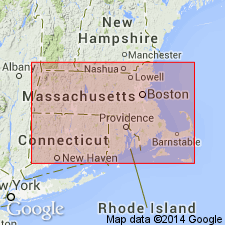
- Usage in publication:
-
- Hallockville Pond Gneiss
- Modifications:
-
- Overview
- Geochronologic dating
- Dominant lithology:
-
- Gneiss
- AAPG geologic province:
-
- New England province
Summary:
Hallockville Pond Gneiss intrudes the Moretown Formation in the Plainfield, MA, 7.5-min quad. It is a light-gray, fine to medium grained, well-foliated gneiss composed dominantly of plagioclase, quartz, biotite, epidote, and chlorite with minor amounts of muscovite, hornblende, calcite, garnet, and pyrite. Protolith is probably a tonalite. Multiple deformation fabrics are clearly visible in the gneiss and authors suggest that the intrusion took place before or during Taconian deformation. Early Ordovician age from zircons (479+/-8 Ma) constrains the age of the previously undated Moretown Formation to Early Ordovician or older. Moretown had been interpreted as Middle Ordovician based on correlations with the Beauceville Formation of southern Quebec and the Missisquoi Formation of VT. The Hallockville Pond is here compared to the tonalitic Collinsville Formation exposed in the Shelburne Falls and Goshen Domes in western MA and also recently dated as Early Ordovician using the same evaporation and U-Pb methods on zircons.
Source: GNU records (USGS DDS-6; Reston GNULEX).
For more information, please contact Nancy Stamm, Geologic Names Committee Secretary.
Asterisk (*) indicates published by U.S. Geological Survey authors.
"No current usage" (†) implies that a name has been abandoned or has fallen into disuse. Former usage and, if known, replacement name given in parentheses ( ).
Slash (/) indicates name conflicts with nomenclatural guidelines (CSN, 1933; ACSN, 1961, 1970; NACSN, 1983, 2005, 2021). May be explained within brackets ([ ]).

